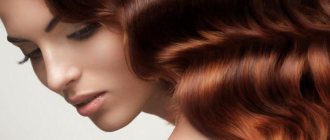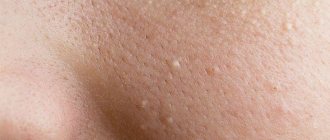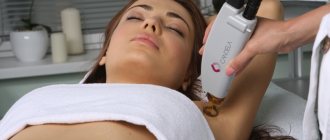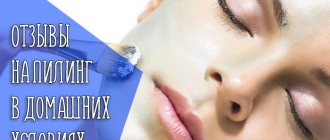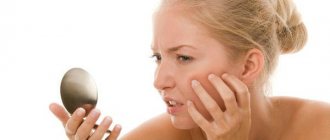Hair structure
To understand the action of a photoepilator, it will be useful to consider the structure of human hair. It has visible and hidden parts.
- The visible part is the rod.
- The part that is under the skin is the hair follicle or root.
The bulb is equipped with a sac - a follicle. In its lower part there is a papilla, consisting of blood vessels and connective tissue. He “manages” the condition and growth of the hair. When the papilla dies, the hair as a whole dies. If the papilla remains alive after some adverse effect, but the hair is dead, then the papilla gives life to a new one.
The visible part of the hair has three layers:
- Internal - the medulla through which nutrition is supplied;
- External – cuticle – protects hair;
- Cortex is the layer between the inner and outer layers.
Cortex is dead cells that give hair elasticity and strength. The cortex contains melanin, the pigment that determines hair color. Melanin is also present in the follicles.
The essence of the photoepilation method
- Photoepilation is a method of removing hair by exposure to high-pulse light. It is based on the ability of melanin, located in the hair shaft and its pigment follicle, to absorb light waves. The photoepilator acts on the blood in the capillaries that feed the bulb through heat waves. As a result of this effect, the blood coagulates, and the follicle, not receiving nutrition, dies, and the hair falls out.
- Light waves are absorbed by hair with varying degrees of intensity, which depends on its color, that is, on the melanin content. Dark hair indicates a large amount of it, and light hair, on the contrary, indicates a small amount. With a large amount of melanin, photoepilation has the greatest effect.
- When removing hair using photoepilation, a device is used that is a source of precisely such light waves that are well absorbed by melanin, and, to a lesser extent, other pigments. In this case, the hair is heated to a temperature of approximately 80 ° C, and all follicle cells, including the papilla, die. Therefore, hair no longer grows.
Important! Once the photoepilation procedure is completed, its impact does not stop. Therefore, hair growth does not resume for a long time in comparison with the use of other methods of hair removal. .
Customers' opinions
“IPL photoepilation is the most painless of the popular hardware procedures. Its essence is that the light wave turns into a heat wave, which kills the hair follicle, the hair follicle closes, and the hairs fall off. Before going to the cosmetologist, I read the reviews. They are very contradictory. This is understandable: the result depends on the thickness and color of the hair. Personally, I needed 5 procedures to get rid of armpit hair. The procedure is quite tolerable: the pain is minor, and the redness goes away after a couple of hours. In general, if the device parameters are set correctly, there will definitely be no burns” - Christina, 29 years old.
“I did photoepilation on my legs. I used to shave my hair, so it became quite coarse and thick. The cosmetologist said that at least 10 procedures would be needed. After the first session, the hair did not grow for a long time. In some areas they still do not grow. In total, I underwent 5 procedures, then minor burns appeared, because of which I temporarily stopped going to the salon. A friend said that it is very important what device the procedure is used on. She had photoepilation done using Quantum IPL. Not a single burn and a minimum of discomfort. I also started going to her cosmetologist. It turned out that the whole point was in the unique cooling system of the device. By the way, in terms of effectiveness it is the best one used today, so I finally got rid of my hair. I hope forever” - Ksyusha, 25 years old.
“Using photoepilation, I removed hair on my chin. They began to grow during pregnancy. My gynecologist said that this is due to hormonal changes. First I plucked, then I went for electrolysis, and finally I came to advanced IPL photoepilation, which in my case turned out to be a godsend. My skin is fair, and my hair grew quite dark. These are the ones that the procedure deals with the fastest. It only took me three sessions and I got rid of my hair forever” - Ilona, 32 years old.
What is good about photoepilation?
- Photoepilation is a non-contact method of exposure.
- Its distinctive property is painlessness, which is especially important when used in the face, armpits, and bikini areas. After all, when using wax or sugar, and even a laser, the sensations experienced by a woman cannot be called pleasant.
- It damages the skin to a minimum.
- Completely eliminates the possibility of infection.
- The procedure does not take much time and lasts from 15 to 60 minutes.
- Any type of hair can be removed, excluding very light and gray hair, which lacks melanin.
- There is a skin rejuvenation effect. This is due to the fact that during photoepilation collagen is rapidly produced.
- The advantage is the rapid effect of the method, which is visible after the first procedures.
- The effect of use lasts for several years, since the light flash neutralizes the follicles for a long time.
- When used correctly and in accordance with the recommendations, the skin in most cases is not damaged or reddened in comparison with the same sugaring or waxing or razor.
- There is no problem of ingrown hairs - their weakening and subcutaneous growth that occurs when using electric hair removal.
Disadvantages of IPL
- The method is quite young, so data on the safety of its use cannot be considered absolutely reliable.
- The procedure is not effective enough when treating light or red colored hair, as well as those lacking pigment (gray hair). Before and after IPL photoepilation
- If you have a tan or dark skin color, photoepilation can be harmful.
- Violation of the rules of conduct leads to burns and/or depigmentation of the skin. The effects last for several months.
- Pain may occur during skin treatment.
- If the device malfunctions or the specialist is insufficiently qualified, damage to the skin or changes in pigmentation of the treated area cannot be ruled out.
- In some cases, peeling may occur.
- The interaction of light rays with melanin can lead to hyperpigmentation.
- The prices for the procedure are quite high.
Contraindications to photoepilation
Important! Before you begin the photoepilation procedure, you need to understand that there are a number of serious restrictions on its use. .
Contraindications to hair removal are factors such as:
- Under 18 years of age.
- Allergic skin reactions.
- Birthmarks.
- Large moles.
- Tattoos.
- Abrasions, wounds, scratches.
- Tanning on the areas of skin to be treated.
- High blood pressure.
- Cardiac ischemia.
- Hormonal imbalances.
- Disorders of the thyroid gland.
- Diabetes.
- Herpes in the acute period.
- Varicose veins
- Malignant and benign skin formations.
- Acute viral infections.
- Worms.
- State of pregnancy.
- Lactation.
- A keloid scar is a growth of rough tissue in the form of a tumor.
- Chronic diseases in the acute stage.
Important! For sensitive skin, it is recommended to carry out a test flash on a certain area and observe it throughout the day. You can continue the procedure only in case of slight redness, and in case of other symptoms, refrain from it. .
Chronic diseases for which you cannot use a photoepilator include:
- lichen;
- lupus erythematosus;
- eczema;
- ichthyosis is a hereditary disease in which a gene mutation appears - “fish scales”;
- scleroderma - thickening and hardening of the skin and connective tissue;
- vesicular dermatosis – formation of blisters on the skin;
- collagenosis is an immunological disease characterized by damage to connective tissue;
- vasculitis - a group of diseases in which the walls of blood vessels are destroyed;
- dyschromia - a violation of the normal color of tissues.
IPL hair removal. The essence of the technique, indications and contraindications.
IPL photoepilation is an innovative technology for hair removal from almost any part of the body. It is based on the property of broadband light to penetrate the skin and have a selective effect on the treated area. In this case, the point of application is the hair pigment – melanin. As a result of light exposure, the production of collagen in the skin is also stimulated, thereby increasing its elasticity.
IPL hair removal is one of the safest and most painless hair removal methods. This is due to the short-term effect of the light flux on the skin and individual selection of the power and duration of irradiation, taking into account the skin phototype and its sensitivity. What is she?
This photoepilation method is based on the use of IPL systems. In them, the light source is a flash lamp, which generates high-intensity incoherent light radiation with wavelengths in the range of 500-1200 nm.
During the procedure, the energy of the light wave is absorbed by the hair pigment melanin. It is he who is able to absorb pulsating light. After this, the light energy is transformed into heat, heating the hair follicle and destroying the vascular papilla that feeds the hair. As a result, IPL photoepilation leads to irreversible destruction of the hair follicle by light. Hair removal does not occur immediately, but over a certain period of time - approximately 5-7 days. The area where the hair follicle is located is gradually filled with connective tissue.
History of the procedure
IPL photoepilation was first proposed by the Swedish physician and engineer Morgan Gustafsson at a dermatology convention held annually in Stockholm. After 5 years, Lumenis Ltd. A patent for the technology was issued, after which mass production of photoepilation devices began. In 2000, the FDA (Food and Drug Administration) recognized IPL as an effective hair removal technology. A year later, they began to use it for the purpose of photorejuvenation. Soon the method began to be used to eliminate age spots and vascular spots.
How it works
As a result of the absorption of light energy, various reactions are triggered in tissues, the main one of which is thermal. After absorbing a large amount of energy, the tissues are heated to a temperature at which their destruction, or thermolysis, begins. During ipl photoepilation, this process is triggered by exposure to light energy, which is why it is called photothermolysis. Light of different wavelengths is absorbed differently by tissues depending on their color, so the effectiveness of photoepilation is largely determined by the presence of the dark pigment melanin in the hair and follicles and the correct selection of light wave parameters. During ipl hair removal, waves of a length that is optimally absorbed by melanin and minimally absorbed by other pigments present in the skin are used. Photothermolysis of the hair follicle with minimal damage to other tissues is called selective.
In cases where, under the influence of selective thermolysis, all the cells of the hair follicle responsible for hair growth die, hair growth stops. If the follicle is simply damaged, the hair growth cycle is disrupted, its thickness and degree of pigmentation are reduced, but it continues to grow.
Solving the Selectivity Problem
Since melanin is found not only in hair and hair follicles, but also in the skin, light waves are also absorbed by the skin. The cells that contain melanin are located closer to the surface than the follicles, so when exposed to light they are damaged first.
Because of this effect, photoepilation methods are most suitable for light skin tones and dark hair. Removing light hair on dark skin is quite problematic. For some types of photoepilation, this factor is a contraindication.
Developers of new ipl systems are working to create technologies to provide skin cell protection while effectively affecting the hair follicle. To do this, various cooling techniques are used, which also reduce pain during the procedure. Modern devices make it possible to choose the wavelength, the “shape” of the light pulse, and “split” it, which increases the effectiveness of irradiation of the hair follicles and minimizes the negative impact on the skin.
IPL hair removal and laser photo hair removal: what is the difference?
In both cases, the active factor is the energy of the light wave. In the initial period of development of photoepilation, only laser radiation was used. But since some properties of the laser beam, such as monochromaticity and coherence, do not play a significant role in hair removal, the development of IPL systems began, which essentially became a more accessible and cheaper option for photoepilation.
The main difference between laser and IPL hair removal:
- Laser radiation is monochromatic, i.e. the waves have the same length. The angle of their divergence is also insignificant. IPL systems are based on the use of a polychromatic spectrum of light radiation. Targeted effects on specific pigments are achieved using filters that narrow the spectrum of emitted light.
- Different types of lasers operate using different wavelengths. IPL uses a wide wavelength range from 500 to 1200 nm. Light filters allow you to highlight a narrower spectrum, but obtaining monochromatic radiation is impossible. Therefore, in terms of selectivity, IPL systems are significantly inferior to laser ones.
- Tanned dark skin is a contraindication for IPL photoepilation. According to expert reviews, the procedure turns out to be completely ineffective.
- The laser beam has a small divergence angle, due to which a significant amount of energy penetrates to the deep layers of the skin. In IPL systems, the divergence angle is much larger, so more energy is required, which causes unnecessary heating of the tissue.
- The production of laser systems is associated with high costs, although in the future there is no need to replace expensive consumables. As for IPL systems, their production is less expensive, but the light-generating lamps are quite expensive.
- The large number of lasers used in cosmetology is due to the fact that each of these devices is intended to solve a specific problem. IPL systems are more universal in this regard: they use a wide range of radiation, and the use of removable filters allows you to receive light with different wavelength ranges from one device to solve a fairly wide range of cosmetic problems.
- The laser produces a light spot with a diameter of up to 1 square. cm. The small impact area is convenient when treating small areas of skin and uneven surfaces. With IPL hair removal, the light spot has a diameter of 2 to 20 square meters. cm, which significantly speeds up the hair removal procedure and reduces its price.
- Removing melanin-free gray hair is not possible with IPL. Therefore, you have to resort to laser techniques (using ELOS) or electrolysis.
As for the pain of the procedure, in this regard both methods are almost equivalent, although theoretically broadband photoepilation should be associated with more pronounced pain, since a significant amount of energy is transferred to the skin, and a larger area is processed per unit of time, and the selectivity of the effect is less. To reduce pain, modern devices use a local cooling system. Advantages of the method
- As a result of the completed course, long-term or permanent hair removal is achieved.
- When hair grows again, it is much thinner and lighter.
- Correct execution of the procedure guarantees its absolute safety.
- IPL systems allow you to treat large areas: legs, back.
Indications
Photoepilation is carried out in the presence of unwanted hair on the face, armpits, legs, arms, and bikini area. It is also prescribed for the removal of spider veins, pigment spots, and also for photorejuvenation. The procedure is also indicated for men – for example, with increased hair growth on the chest and back.
IPL hair removal is also prescribed for medical reasons. The main ones:
- hypertrichosis – intense growth of body hair;
- hirsutism – male pattern hair growth in women due to excess levels of male hormones in the body;
- increased skin sensitivity, leading to frequent facial irritation after shaving.
Contraindications
General contraindications to any type of photoepilation are:
- hypertonic disease;
- cardiac ischemia;
- systemic pathologies;
- oncological diseases;
- diabetes mellitus (decompensated stages);
- tendency to keloid scars;
- infectious diseases;
- feverish conditions;
- hemophilia and other diseases accompanied by blood clotting disorders;
- photodermatoses (skin diseases leading to increased sensitivity to sunlight);
- taking steroids, isotretinoin, photosensitizing drugs (hormonal contraceptives, tetracyclines, retinoids, fluoroquinolones);
- allergic reaction to sunlight, porphyria, SLE;
- epilepsy, tendency to seizures;
- mental illness;
- the presence of electronic devices in the body: insulin pump, pacemaker;
- pregnancy and breastfeeding (due to changes in hormonal levels, the effectiveness of photoepilation is reduced).
In case of increased thyroid function and polycystic ovary syndrome, prior IPL photoepilation requires preliminary normalization of hormonal levels.
Local contraindications are:
- infectious and inflammatory skin diseases;
- the presence of varicose veins in the treated area;
- Permanent makeup;
- tattoos;
- recent use of self-tanning or fresh tanning;
- presence of “golden threads” in the skin;
- local use of medications with photosensitizing properties (in particular, we are talking about essential oils);
- the presence of neoplasms or nevi on the skin.
Exposure to light waves is extremely dangerous for both flat and raised moles (nevi). It can cause burns and even malignant degeneration of the formation. Hair removal is possible only after removal of the nevus. Before this, the only way to get rid of the hair growing from it was to cut it.
Before photoepilation
Sunbathing and the use of self-tanning are not recommended 15-20 days before the planned procedure. Exposure to intense light irradiation on tanned skin leads to burns.
After 2-4 weeks, hair can be removed only by shaving. Other methods of depilation are unacceptable, since the procedure is effective only if there is hair in the follicle - otherwise, absorption of light energy does not occur.
The optimal length of hair to be epilated is 1-2 mm. The cosmetologist must certainly see the area of their growth, however, with a greater length, the hair burns or melts during hair removal, thereby causing burns.
The need and timing of shaving the treated area are previously discussed with the doctor, since in some cases the hair is removed immediately before the session using a trimmer.
After the procedure
As a rule, for several hours after the session, sensations similar to a sunburn persist. To eliminate them, you can use wound healing and anti-inflammatory agents. Panthenol spray is very effective.
In the initial period, so-called false hair growth is possible, when dead hair is pushed out of the follicle. They fall out on their own within 10-15 days.
- For the first three days, it is recommended to limit water treatments and avoid visiting the pool, bathhouse and sauna.
- It is better not to use cosmetics in the treated area for approximately 5-7 days.
- You cannot sunbathe for 20-25 days. When forced to stay under the sun, it is necessary to apply sunscreen with a high level of ultraviolet protection to the skin.
- During the IPL photoepilation course, you should not use any other hair removal methods other than shaving.
Take care of yourself and be beautiful!
Side effects of photoepilation
Important! You need to be prepared for the fact that negative side effects may occur after photoepilation .
These negative consequences include:
- Tissue burn . It may appear if you treat heavily tanned skin that has a high melanin content. You can also burn your skin if it is thin, dehydrated, or has increased photosensitivity.
- Folliculitis is a pustular disease of the hair follicle. It can occur if a person suffers from hyperhidrosis, that is, he experiences increased sweating. And also in cases where in the first days after taking the procedure, a swimming pool, sauna or bathhouse is often visited.
- Allergic reactions . May occur in those prone to allergies to the sun or to medications that cause anesthesia.
- Acne . Most likely in dark-skinned and younger patients.
- The appearance of gray hair . It happens rarely.
- Skin pigmentation disorder . It occurs as a result of skin burns and appears as light spots.
- Sweating disorder . It appears when the follicles are damaged.
- Decreased vision . It is most often detected when applying hair removal in the eyebrow area, if special protective equipment is not used - glasses or metal contact lenses.
- Scars . They are a consequence of burns.
- Malignant degeneration of the skin . It can occur when moles are irradiated with a strong light flux.
- Increased hair growth . This is explained by the low density of light flux, which does not cause hair loss, but stimulates its growth.
- Peeling and itching of the skin . They may appear due to too intense and prolonged exposure to the photoepilator.
- Exacerbation of herpes . Occurs when herpes was previously present in the treated area.
Indications
Photoepilation is carried out in the presence of unwanted hair on the face, armpits, legs, arms, and bikini area. It is also prescribed for the removal of spider veins, pigment spots, and also for photorejuvenation. The procedure is also indicated for men – for example, with increased hair growth on the chest and back.
IPL hair removal is also prescribed for medical reasons. The main ones:
- hypertrichosis – intense growth of body hair;
- hirsutism – male pattern hair growth in women due to excess levels of male hormones in the body;
- increased skin sensitivity, leading to frequent facial irritation after shaving. IPL photoepilation for men
Some nuances of using photoepilation
In order for photoepilation not to bring disappointment, you need to be prepared for the fact that it may not always be as effective as advertising calls say.
- The hair removal course must be repeated once every five years. During this time, new follicles are formed, giving life to the hair.
- It is advisable to take maintenance procedures once every six months.
- It would be a good idea to visit a dermatologist before photoepilation.
- There is no need to apply depilatory creams before the session.
- Before photoepilation, it is forbidden to sunbathe on the beach or visit a solarium for three weeks, since hair is removed more easily from light skin.
- You should also limit sunbathing for two weeks after the session.
- It is also not recommended to use cosmetics during the same two weeks if facial hair has been removed.
- When epilating in the armpits, it is better not to use antiperspirants for a couple of weeks to avoid skin irritation.
- If hair removal is performed before the procedure, then this can only be done with a razor, and not resort to pulling out (wax, sugaring, tweezers). But it’s better to avoid such manipulations altogether.
History of the procedure
IPL photoepilation was first proposed by the Swedish physician and engineer Morgan Gustafsson at a dermatology convention held annually in Stockholm. After 5 years, Lumenis Ltd. A patent for the technology was issued, after which mass production of photoepilation devices began. In 2000, the FDA (Food and Drug Administration) recognized IPL as an effective hair removal technology. A year later, they began to use it for the purpose of photorejuvenation. Soon the method began to be used to eliminate age spots and vascular spots.
Disadvantages of photoepilation
There are also disadvantages to using photoepilation.
These disadvantages include:
- Dark hair is removed easier and faster, while light and gray hair remains.
- The effect is not achieved with dark skin tones.
- You cannot limit yourself to one procedure; you need to carry out several.
- Periodically, courses need to be repeated after a certain number of years.
- Carrying out photoepilation is an expensive pleasure. The cost of one session is from 10 to 12 thousand rubles.
- If you use home photoepilation, you will have to spend money on a device, the minimum cost of which is about 20 thousand rubles.
How is the photoepilation procedure performed?
Important! Before the procedure, be sure to wear glasses to protect from bright light flashes. .
- The area to be treated is covered with a special gel that has a cooling effect that prevents skin damage.
- Actually, a procedure during which the tip of the device slowly moves over the skin surface. Usually no unpleasant effects are observed, with the exception of slight tingling and tingling in some cases, especially in the armpits and bikini area. The duration of the procedure can be from 15 minutes to one hour. This depends on the area of the treated areas.
- At the end of the session, a soothing ointment is applied.
- The rehabilitation period lasts about a week. At this time, it is better to refrain from using cosmetics, visiting a bathhouse, sauna or swimming pool.
Important! To achieve maximum effect and completely remove hair in unwanted places, it is necessary to conduct from three to seven sessions .
Negative consequences most often occur in the following cases:
- The above contraindications are not taken into account or the recommendations are not followed.
- A salon has been selected where sanitary standards are not observed or where insufficiently qualified specialists work.
- Low-quality cooling gel was used before the procedure or cream after it.
Important! If you use photoepilation at home, you must definitely monitor the light energy flux density in order to avoid burns at high levels, and also to prevent increased hair growth at low levels. .
Execution method
During the session, both the client and the doctor must wear special protective glasses. The essence of the procedure is to press the photoepilator handpiece to the treated area and fire a flash with full contact of the emitting part with the surface of the skin. After this, the working part is moved to a neighboring area. Depending on the size of the surface being treated, the duration of the session can be from 5 minutes to an hour. If hair removal is performed under anesthesia, the duration of exposure increases. As a rule, the procedure is not accompanied by pain. When treating sensitive areas of the skin (for example, the bikini area), a slight burning or tingling sensation may occur. In such cases, to reduce discomfort, the interval between outbreaks is increased.
After the session, the cosmetologist removes the gel and applies a soothing cream or aerosol with softening, anti-inflammatory or moisturizing properties to the epilated surface.
Is it possible to use photoepilation during pregnancy?
Doctors do not recommend photoepilation during pregnancy. To date, no direct negative effects on the fetus have been detected. But the fears of doctors are related to the fact that the reaction of a pregnant woman’s body to photoepilation has not been fully studied and is therefore unpredictable. There is an assumption that an allergic response and swelling of not only the skin, but also other organs cannot be ruled out. Therefore, in order to avoid irreversible consequences for the mother and unborn child, it is advisable to abandon photoepilation and use the machine.
Add a comment

